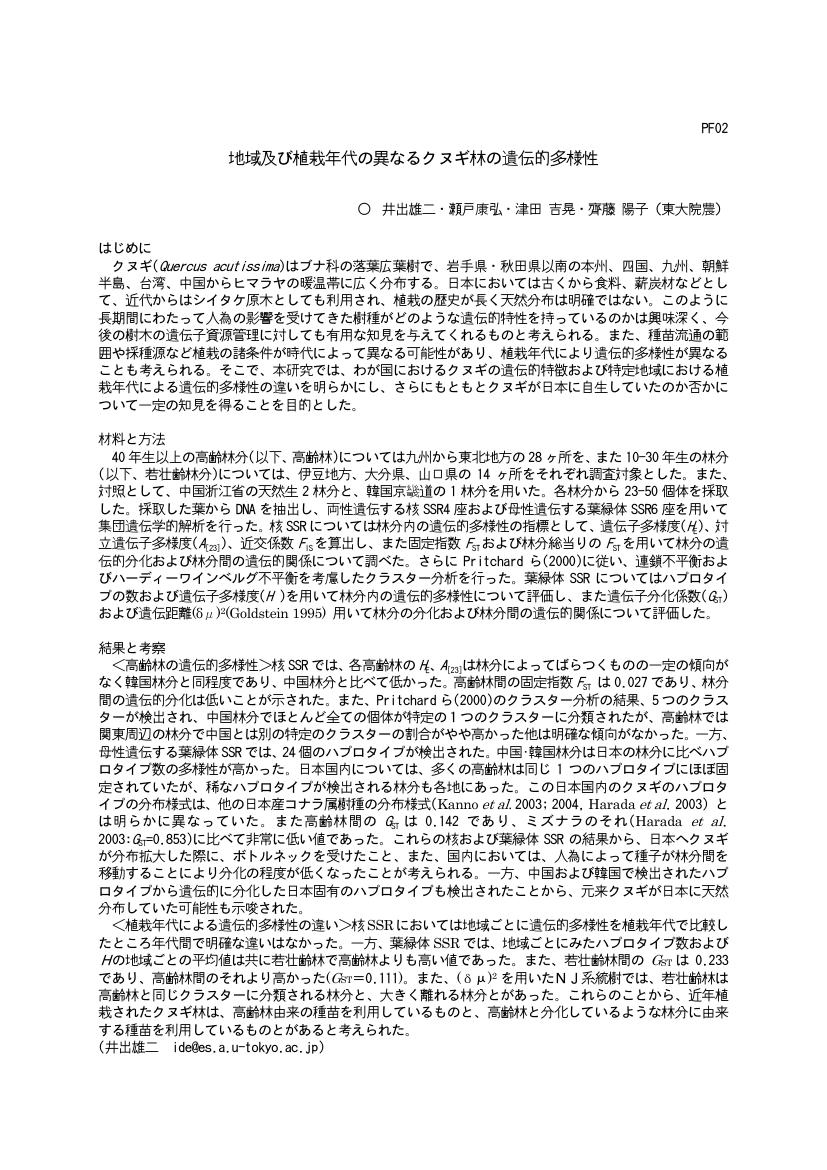8 0 0 0 OA クヌギの遺伝的多様性に関する研究 河川沿いに生育する個体の葉緑体SSRによる解析
2 0 0 0 OA クヌギおよびアベマキの核DNAの地理的変異
- 著者
- 齊藤 陽子 内山 憲太郎 井出 雄二
- 出版者
- 日本森林学会
- 雑誌
- 日本森林学会大会発表データベース 第120回日本森林学会大会
- 巻号頁・発行日
- pp.798, 2009 (Released:2009-03-17)
2 0 0 0 OA 地域及び植栽年代の異なるクヌギ林の遺伝的多様性
2 0 0 0 IR 古文書に記録された1811年の伊豆天城山の森林状況
- 著者
- 井出 雄二 黄 バーナード永龍 指村 奈穂子
- 出版者
- 東京大学大学院農学生命科学研究科附属演習林
- 雑誌
- 東京大学農学部演習林報告 (ISSN:03716007)
- 巻号頁・発行日
- no.128, pp.87-120, 2013-02
江戸時代中期以降伊豆韮山代官であった江川家に伝わる文書の内,「天城山御林改木数字限仕訳帳」を読み解き,1811年における天城山の森林の状態を考察した。仕訳帳の調査範囲は暖温帯から冷温帯までの広い範囲を含んでいた。また,仕訳帳には調査面積に関する記述はなかったが,仕訳帳の地名と現在の地名との対応から,その範囲は少なく見積もった場合でも500ha程度であることを示した。樹種構成は,今日の天城山の天然林とほとんど変わらなかったが,立木密度は100本/ha以下で今日の天然林の平均500本/haと比べると大変疎であり,大径木が優占した林相であったと推定された。これは,目通り直径14.5cm以下の雑木を継続的に炭焼きに供したため,より上の径級へ進界できる雑木が存在しなかったことに起因すると考察した。疎な林床ではモミ稚樹の更新が卓越し,さらに別木としての保護が加わり,モミ林の形成がうながされた。また,同様なことがブナでも起こった可能性がある。このような人為によって誘導された森林状態が,今日残存する天城山の天然林の成立に深くかかわっていたものと考えられた。
1 0 0 0 IR 植栽年代の異なるクヌギ人工林の遺伝的組成 : 大陸産種苗植栽の可能性
- 著者
- 齊藤 陽子 瀬戸 康弘 井出 雄二
- 出版者
- 東京大学大学院農学生命科学研究科附属演習林
- 雑誌
- 東京大学農学部演習林報告 = Bulletin of the University of Tokyo Forests (ISSN:03716007)
- 巻号頁・発行日
- no.137, pp.65-75, 2018-03
クヌギは,1960年代以降シイタケ原木として需要が高まり,急激に造林が進んだ。この時代の前後でクヌギ人工林が遺伝的に異なるかを明らかにするため,静岡,山口,大分で,クヌギ高齢人工林6林分,壮齢人工林13林分および対照として大陸の韓国1集団,中国2集団,計990個体を核SSRマーカー7座および葉緑体SSR6座で解析した。その結果,核DNAの多様性は中国集団が高く,日本の人工林では林齢区分や地域による明確な違いはなく,韓国集団と同程度であった。またSTRUCTURE解析では,K=3の時,中国集団が異なるクラスターを形成した。葉緑体ハプロタイプは16個検出され,静岡5林分中4林分,山口全3林分,大分11林分中4林分で同じ特定のハプロタイプの頻度が90%以上であった。一方,大陸ではそのハプロタイプの頻度は低かった。葉緑体の(δμ)2に基づき近隣結合法により作成した系統樹では,大陸と日本の2つのクレードが形成されたが,その中間に位置する人工林もあった。ハプロタイプの多様度は,高齢林より壮齢林で高い傾向があった。これらのことから,地域によっては1960年代前後でクヌギ人工林の遺伝的特性が異なり,韓国産種苗がそれにかかわっていた可能性があることが示唆された。
1 0 0 0 「伊豆林政史ー資料編」詳細目録の調製
- 著者
- 井出 雄二
- 出版者
- 日本森林学会
- 雑誌
- 日本森林学会大会発表データベース
- 巻号頁・発行日
- vol.131, 2020
<p>昭和39年に東京営林局から発行された、「伊豆林政史」は、後北条時代から明治時代までの天城山の森林管理について、資料に基づき幅広く紹介したもので、森林史を考究する上で重要な文献である。この論考の基礎とされた資料が資料編として保存されている。これらは、昭和34年から二か年、弓削俊昭が公務として収集した伊豆各地の旧家所蔵の古文書の書き写しなど約1,200点からなり、これまで天城山の森林管理や利用に関する論文に引用されてきた。収集から60年が経ち、古文書原本へのアクセスが困難になる中、資料編の文書群の価値はますます高まっている。しかし、具体的記述については、資料編を直接参照する以外にその内容を知ることができない。ところが、資料編には、ページが振られていないうえ、目次、索引も存在せず、必要な資料を探し出すことは大変困難である。そこで、筆者は、資料編の活用を期し、その画像ファイル(PDF)を作成するとともに、詳細な目録を調製した。なお、資料編は、その学術的価値から、日本森林学会の「林業遺産」(2016年度)に選定されており、令和元年9月現在、関東森林管理局伊豆森林管理署に保管されている。</p>
1 0 0 0 OA 日本産アベマキ(Quercus variabilis)の遺伝構造
- 著者
- 齊藤 陽子 津田 吉晃 内山 憲太郎 福田 知秀 井出 雄二
- 出版者
- 森林遺伝育種学会
- 雑誌
- 森林遺伝育種 (ISSN:21873453)
- 巻号頁・発行日
- vol.7, no.1, pp.1-10, 2018-01-25 (Released:2020-04-22)
- 参考文献数
- 60
アベマキは二次林構成種であり、人里近くに多く見られる。本研究では本州のアベマキを対象に、7集団について核 DNAおよび葉緑体 DNA由来の SSRマーカーを用いて遺伝構造を調べた。葉緑体 DNAではアベマキの全個体が1つのハプロタイプに固定しており、過去のボトルネックの経験と近年の急速な分布拡大が示唆された。アベマキの核 DNAの遺伝的多様性は高く(平均RS=4.58、HE=0.694)、ある程度の集団間分化もみられた(F’ST=0.087.0.100)。STRUCTURE解析では、アベマキから2つのクラスターが検出され、東北の1集団を除いて、これら2クラスターの混合パターンがみられた。一方、日本原産の多くの樹種とは異なり明確な空間遺伝構造は見られず、人為の影響は否定できなかった。近縁種であるクヌギとの種間関係も評価したところ、葉緑体DNAはアベマキと同一のハプロタイプに固定されている一方、核DNAでは明確な種分化がみられた。また両種が同所的に生育する集団では種間混合パターンが見られた。これらのことからアベマキの遺伝構造の理解には過去の分布変遷の他、人間活動の影響や種間交雑も考慮すべきことがわかった。
1 0 0 0 ヒメシャラの系統地理学的研究にもとづく植栽個体の産地識別
1 0 0 0 OA ユビソヤナギの広域的な潜在生育域推定及び分布変遷に関する考察
- 著者
- 指村 奈穂子 池田 明彦 井出 雄二
- 雑誌
- 東京大学農学部演習林報告 (ISSN:03716007)
- 巻号頁・発行日
- no.123, pp.33-51, 2010-07 (Released:2011-07-26)
絶滅危惧植物ユビソヤナギの保全方法の検討資料とするため、ユビソヤナギの潜在生育域を推定し、その結果を踏査により検証した。推定は東北地方から中部地方にかけての地域において、気候、地形、地質などの環境要因に基づきGISを用いておこなった。また、過去の生育域を地史的な気候変動との関係から推定し、現在の分布への影響を考察した。ユビソヤナギの既知生育地は、温量指数60.1〜85.5、積雪深80cm以上、TPI値-3〜0、河床勾配0.1%〜6.3%、集水域に占める花崗岩系と第三紀層の合計地質割合61.7%以上の範囲内に分布していたため、これらの条件が対象地域内の河川において重なる範囲を潜在生育区間と推定した。その結果248区間が選択され、既知生育地のほとんどはこれらの区間に含まれていた。このうち54区間を踏査し、新たに7区間にユビソヤナギの生育を確認した。このことから本推定の確からしさが証明された。また、ユビソヤナギの過去の生育可能域は、最終氷期最盛期(約20,000年前)には日本海側の丘陵地2ヶ所ほどに、縄文海進期(約6,000年前)には脊梁山脈沿いの狭い地域に限定されていたと推定された。なおこれらの地域から離れた場所には、先に推定された潜在生育区間であっても現在ユビソヤナギの生育は認められなかった。ユビソヤナギの潜在生育区間は、温度や積雪、地形、地質などの制限により非常に限定的であり、個体群の維持や分布地の拡大は容易ではない。同時に、その地質地形的特徴から、治山・砂防ダム、貯水ダムが作られやすいと考えられた。そのため、未知のユビソヤナギの生育地を早急に発見し、現在分布している河川において適切な保全対策をとることが緊急の課題であると考えられた。
これまでマングローブ林を農地開発した場所や開拓地で第四系海成堆積物を起源とした酸性硫酸塩土壌が問題となってきた。しかし農地開発や土木工事の規模が大きくなるにつれ、第三系堆積岩を起源とする酸性硫酸塩土壌の生成も顕在化してきた。本研究により、酸性硫酸塩土壌の母材となるパイライトを含む第三系堆積岩が、これまで問題となっていなかった場所も含め、広く日本に分布することがわかった。インドネシア東カリマンタン州やタイ南部でパイライトを含む第三系堆積岩を発見し、これまで第四系堆積物のみが問題となっていた熱帯地域においても、今後開発にともない第三系堆積岩を起源とする酸性硫酸塩土壌が問題となる可能性があること明らかにした。常磐自動車道の建設地で露出した古第三系堆積岩からは酸性化により特徴的にマンガンの溶出が起こり、植栽された樹木にもマンガンの過剰障害が顕著に現れた。このような強酸性土壌には低pHに対する耐性だけでなく、マンガン過剰に対する耐性が植栽樹木に要求される。このため比較的マンガン過剰に耐性があると考えられるシラカンバを用いて、マンガンによる障害の発生機構を調べ、光合成系に障害が発生することがわかった。熱帯産マメ科樹木のAcacia mangiumとA.auriculiformisは、低pHやマンガン、アルミニウムの過剰に対して耐性が大きく、熱帯での酸性硫酸塩土壌による荒廃地の森林再生に有効な樹種であることがわかった。さらなる耐性をもつ新樹木の作成にむけて、A.mangiumとA.auriculiformisの組織培養系を確立し、さらにA.mangiumの細胞培養系を用いて低pHとマンガン過剰に対する細胞レベルの反応を明らかにした。また高マンガン耐性細胞系の選抜をおこなった。これらの研究を基盤にして、酸性土壌に起因するストレスに対する耐性機構を解明し、また新たな耐性の付与を行い、荒廃地への造林樹種の開発と森林再生を目指して研究を進めて行く。
1 0 0 0 材線虫病の病原性と誘導抵抗性機構の解明
1.材線虫病感染後の光合成・蒸散などのマツの生理的変化と萎凋・枯死機構との関連について検討を加えた結果、これらの生理的変化はキャビテーションが或る程度以上進行した後に、水ストレスの発現と同時に、あるいは、それ以降に生ずる現象であることが明らかにされた。2.材線虫の病原性と電解質の漏出現象との関連について細胞レベルで検討した結果、病原力の強弱に応じてマツ組織への影響が異なり、その強さに応じて電解質の異常な漏出が生じることが明らかにされた。3.材線虫病感染組織で産生されるセルラーゼについて検討した結果、このセルラーゼは真核生物起源であり、生きた細胞からの電解質の漏出を高めることが明らかにされた一方、抵抗性マツでは、この電解質の漏出は殆ど見られない。4.強・弱病原線虫を用いて、マツ組織細胞の応答について組織化学的に検討を加えた結果、DAPI染色によって組織細胞の生死の判定が容易となり、この方法を用いて病原性の差異を判別することが可能となった。5.誘導抵抗性の発現について検討した結果、誘導抵抗性はマツ樹体にストレスがかからない条件下、すなわち気象環境によるストレスと弱病原線虫によるストレスが、あるバランスを保った時にのみ誘導される現象であると考えられた。
- 著者
- 井出 雄二 山本 茂弘
- 出版者
- 東京大学大学院農学生命科学研究科附属演習林
- 雑誌
- 東京大学農学部演習林報告 (ISSN:03716007)
- 巻号頁・発行日
- no.85, pp.p27-42, 1991-07
- 被引用文献数
- 1
ウダイカンバ及びダケカンバ冬芽を供試体としての培養を行った。培養試験は,外植体として用いる冬芽の,採取時期及び枝上での位置の違いによる,シュートの伸長経過の違いを検討した。それぞれの樹種2個体について,10月下旬から3月下旬まで,ほぼ1ヵ月おきに6回にわたり,時期をかえて培養を行った。改変ANDERSON培地にBAP(6-benzylaminopurine)を1.6mg/l添加した培地に,鱗片を除いた冬芽を置床し培養した結果,両樹種についてつぎのことが明らかになった。1)培養開始時期が遅くなるにつれて,シュートの形成が悪くなる傾向が認められ,両種共1月以降の培養ではシュートは得られなかった。すなわち,発根培地に移殖可能なシュートを得るためには,北海道においては遅くとも11月下旬までに培養を開始する必要があり,効率的な増殖のためには,本試験の範囲では10月下旬の培養が適当である。これは,静岡での試験との関係でみると,冬芽形成後月平均気温が5℃を下回らない時期が適当であると示唆される。2)シュートの形成及び伸長は,枝の上部に位置する冬芽では旺盛であったが下部の冬芽からは少なかった。この結果,ウダイカンバでは一年生枝先端の仮頂芽及び2番目の冬芽を,ダケカンバでは仮頂芽のみを用いた場合に,良好なシュートの形成が期待される。なお,シュートの伸長は個体間差が大きく,新しい個体の培養に際しては,培地に添加するBAPの量などの培養条件について,個体毎に検討が必要である。3)両樹種とも,10mm以上に伸長したシュートを切り取って改変したANDERSON培地に,IBA(Indolebutylic acid)を0.5mg/l,NAA(α-naphtylacetic acid)を0.02mg/l添加した発根培地に移植することにより,発根個体を得ることが出来た。これにより,ミズメ,ウダイカンバに次いでダケカンバにおいても冬芽の培養による,植物体再生が可能であることが明らかになった。Effects of seasonal and positional difference of winter buds on shoot elongation were examined in vitro winter bud culture of Betula maximowicziana REGEL and B. ermanii CHAM. Two 30-year-old mature individuals growing in the university forest in Hokkaido were used as the source of explants for each species, respectively. Inoculations were carried out six times from October, 1989 to Mach, 1990 at an interval of about a month. Winter buds which scales had been removed were cultured on modified ANDERSON's medium with 1.6mg/l of BAP (6-benzylaminopurine). Shoot formation and elongation was reduced with the advance of inoculation season. It was concluded that winter bud culture of these two species should start at the end of November at latest. And the end of October was thought to be most favorite time for starting culture as far as this experiment concerned. Active shoot formation and elongation was expected from winter buds which were attached on the upper part of one-year-old twigs. Then upper two winter bud including pseudo-terminal bud for B. maximowicziana and only pseudo-terminal buds for B. ermanii supposed to be appropriate for the explandts. Shoot elongation varied seriously from indiviaual to individual in both species. There-for experiments for determination of appropriate culture conditions such as concentration of BAP would be necessay for the propagation of new individual. Shoots which elongated over 10mm were cut and placed on rooting medium which was modified ANDERSON's medium containing 0.5mg/l of IBA (indolebutylic acid) and 0.02mg/l of NAA (α-naphtylacetic acid) after 90 days of inoculation. Rooting were occurred in both species and regenerated plantlets in a few weeks. This is the first report of in vitro plantlet tegeneration of B. ermanii.


